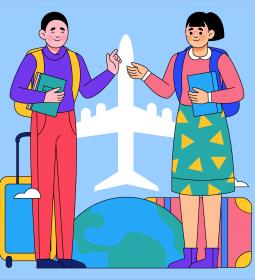A cross-country study conducted in the fall of 2023 on the material of secondary schools from several countries demonstrated that the trends laid down during the coronavirus epidemic have finally been largely defeated! The number of schoolchildren is growing steadily for the first time (although it has not yet reached the previous pre-COVID level), and the authorities and owners of private schools began to actively invest in the development of educational institutions after a three-year break.
We will tell you about the key provisions of this rather interesting study: what is happening in the world secondary education now?
The Great Chinese Exodus

The most noticeable trend was the decline in the number of students from China.
In fairness, the trend towards a decrease in the number of Chinese applicants is long-standing, the process began even before the coronavirus.
For example, in Australian schools, over 5 years (from 2018 to 2023), the share of students from China among foreigners decreased by 8%, from 51% to 53%. In the UK, their number decreased by 3% (to 21%), in Canadian schools there were 12% fewer Chinese, and in the United States, the drop is record-breaking, almost 2 times: if in 2018 there were 42% of the total population of foreign students, then five years later - only one in five.
On the other hand, the Chinese are still the dominant ethnic group not only in Australia, but also in Canada and China, as well as in France, the Netherlands, the UAE, and Thailand.
What is the reason for this state of affairs and who came to replace the Chinese?
Import substitution

Over the past five years, Chinese secondary education has made a qualitative leap - both public and private.
- First, the authorities have decisively taken up language centers and branches of international schools. Previously, in pursuit of easy money, their organizers, under the guise of qualified specialists, invited anyone from abroad - up to senior students, and not always even in the profile. These people, being registered unofficially, received a solid salary, but were not protected in any way from the possible consequences of their illegal work: one complaint or a random inspection - and the director disowned the employee, taking advantage of the latter's ignorance of Chinese laws and errors in employment contracts. After that, at best, the poor guy was exiled, and at worst, he was also imprisoned for several months or awarded large fines.
- The situation of students and their parents turned out to be even worse: they invested a lot of money for their child to learn English, and in return they received a service of mediocre quality. Such studying was more likely to do harm than good.
Now everything is different, and the PRC relies on national personnel: pedagogical universities have been doubling or even tripling their enrollment for several years, and before entering a school, foreign teachers are required to undergo complex and multi-level checks, confirm their qualifications with original documents.
Such a policy has already brought benefits, especially since the closed borders against the backdrop of the pandemic actually made the situation hopeless for parents: like it or not, they had to choose what they could get to (especially since distance lessons with the participation of foreign teachers in 2022 in China fell under a strict ban).
A holy place is never empty

Despite some outflow in the number of students, there is no need to talk about a landslide growth - students from other countries have come to replace the Chinese. For example, Australian schools have seen an increase in the proportion of Vietnamese, Japanese, South Korean and Hong Kong students. The last year has seen a significant increase, and now the number of expat students has almost reached 70% of pre-pandemic levels (up from 48% a year ago, this is a great result!).
However, Australian teachers note that applicants from other East Asian countries who have replaced the Chinese are much less prepared, they have serious difficulties with English. Therefore, many schools will open additional preparatory classes this year, and in linguistic schools, accordingly, educational programs that combine the study of the language and basic academic subjects (primarily mathematics) are breaking records. For Australians, this is rather good news, but not so much for parents of new students, since the price tag for tuition has also noticeably increased compared to the previous year.
Canadian schools also note "import substitution", and Koreans, Japanese and Vietnamese are predictably joined by children from Mexico, Nicaragua and some South American countries. The number of European, primarily German, Italian and Spanish students is also growing.
In the United States, the Chinese are still the dominant group, but they are hot on the heels of the Koreans, Vietnamese, and America's neighbors on the continent from Mexico and Canada.
But in schools in the United Kingdom, the trend is exactly the opposite, the share of Chinese is growing, and China occupies the first two lines at once: Hong Kong is recognized as the leader (since 1999 it has been an autonomous region of the PRC), and the PRC itself is in second place with a slight lag. The top 10 also includes Germans, Spaniards, Turks and Nigerians.












